Relevance of value management
VerifiedAdded on 2022/08/27
|15
|3446
|18
AI Summary
Contribute Materials
Your contribution can guide someone’s learning journey. Share your
documents today.
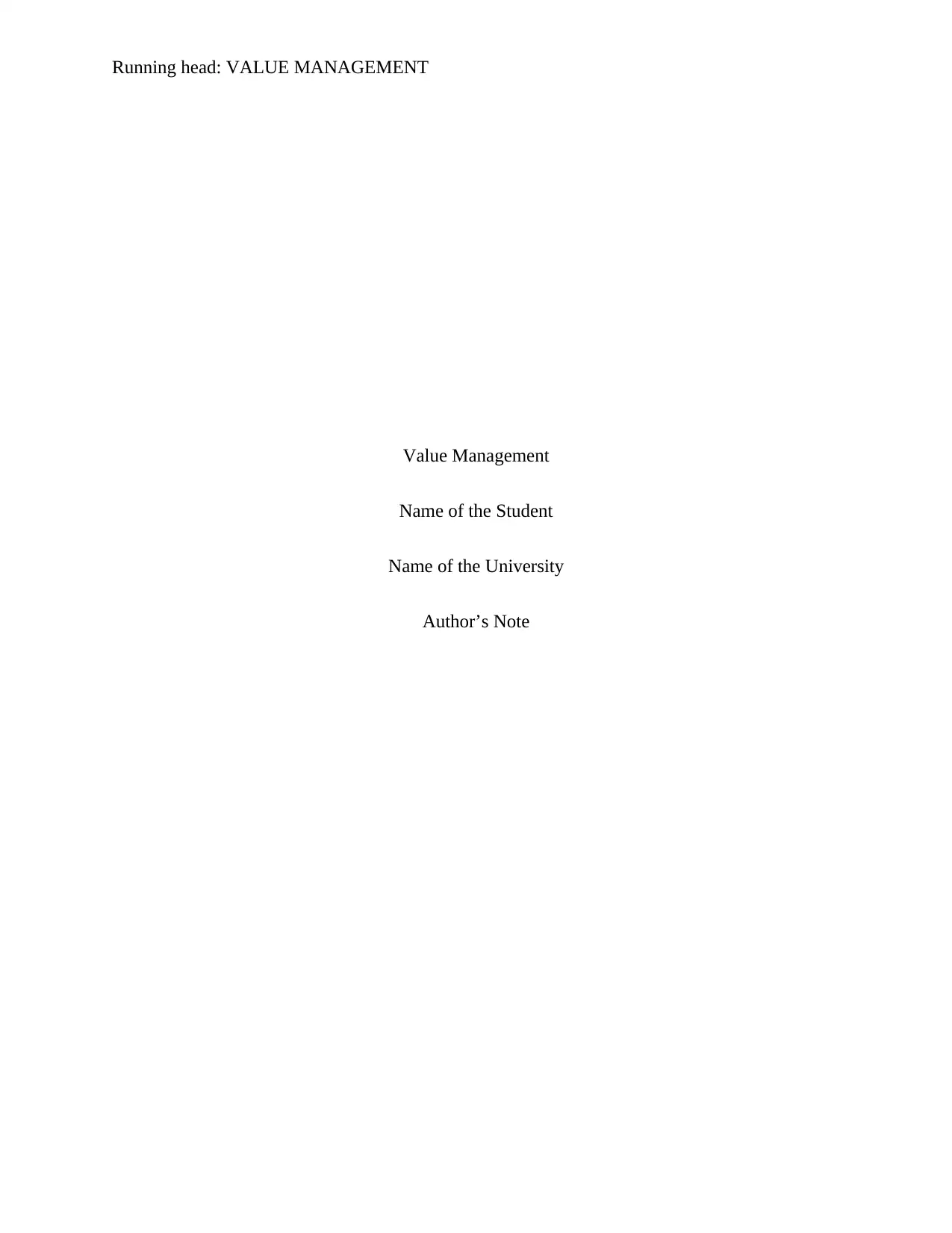
Running head: VALUE MANAGEMENT
Value Management
Name of the Student
Name of the University
Author’s Note
Value Management
Name of the Student
Name of the University
Author’s Note
Secure Best Marks with AI Grader
Need help grading? Try our AI Grader for instant feedback on your assignments.
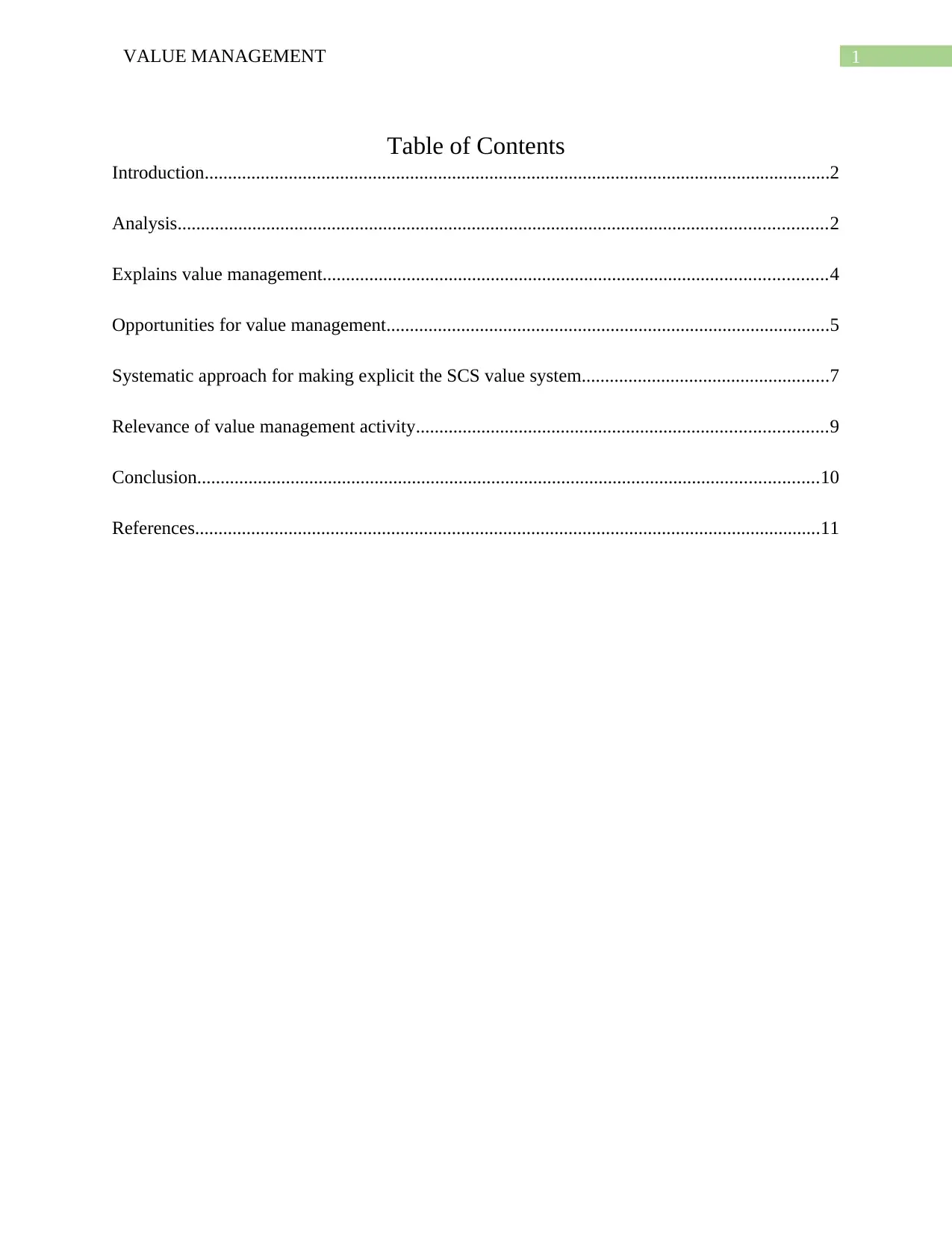
1VALUE MANAGEMENT
Table of Contents
Introduction......................................................................................................................................2
Analysis...........................................................................................................................................2
Explains value management............................................................................................................4
Opportunities for value management...............................................................................................5
Systematic approach for making explicit the SCS value system.....................................................7
Relevance of value management activity........................................................................................9
Conclusion.....................................................................................................................................10
References......................................................................................................................................11
Table of Contents
Introduction......................................................................................................................................2
Analysis...........................................................................................................................................2
Explains value management............................................................................................................4
Opportunities for value management...............................................................................................5
Systematic approach for making explicit the SCS value system.....................................................7
Relevance of value management activity........................................................................................9
Conclusion.....................................................................................................................................10
References......................................................................................................................................11
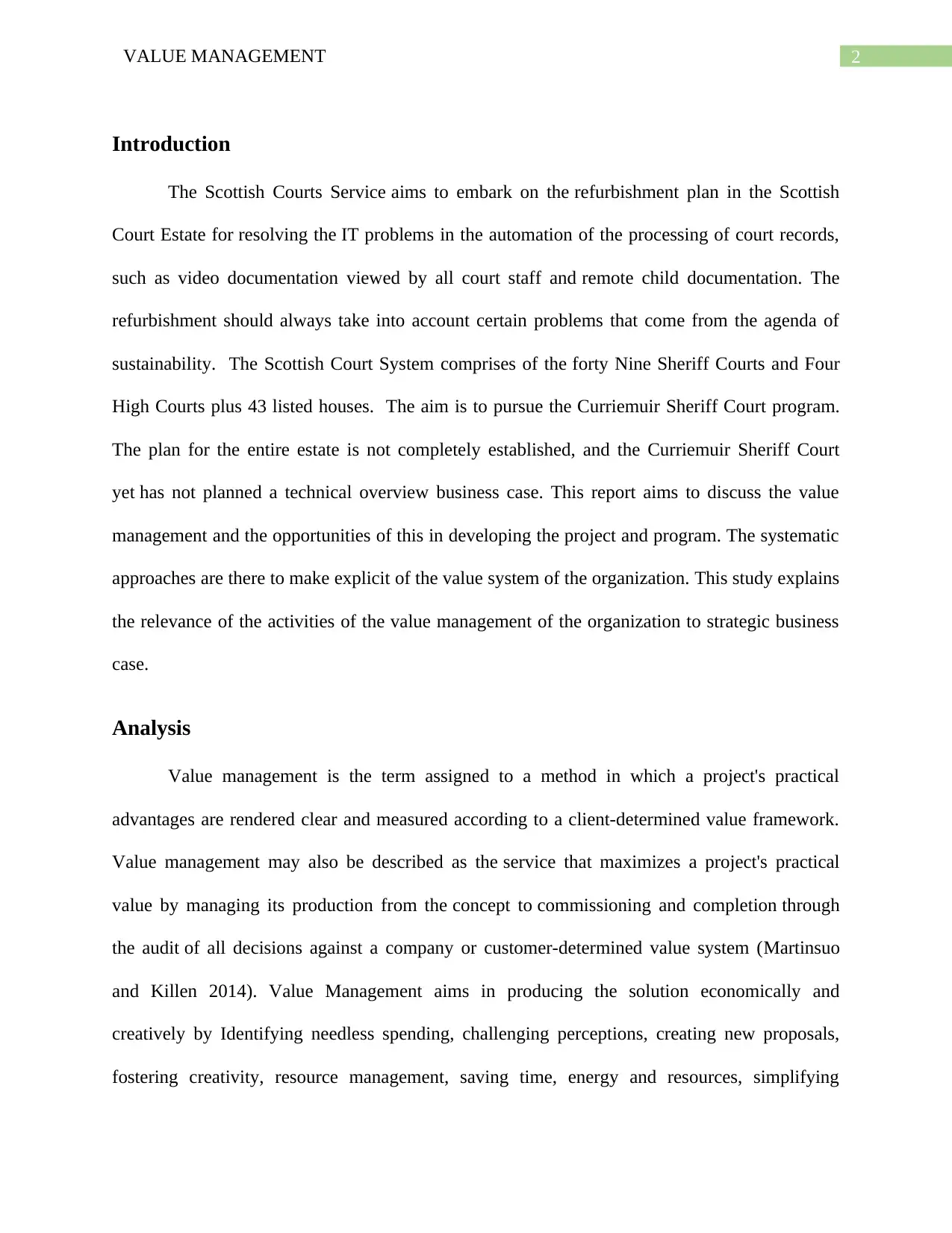
2VALUE MANAGEMENT
Introduction
The Scottish Courts Service aims to embark on the refurbishment plan in the Scottish
Court Estate for resolving the IT problems in the automation of the processing of court records,
such as video documentation viewed by all court staff and remote child documentation. The
refurbishment should always take into account certain problems that come from the agenda of
sustainability. The Scottish Court System comprises of the forty Nine Sheriff Courts and Four
High Courts plus 43 listed houses. The aim is to pursue the Curriemuir Sheriff Court program.
The plan for the entire estate is not completely established, and the Curriemuir Sheriff Court
yet has not planned a technical overview business case. This report aims to discuss the value
management and the opportunities of this in developing the project and program. The systematic
approaches are there to make explicit of the value system of the organization. This study explains
the relevance of the activities of the value management of the organization to strategic business
case.
Analysis
Value management is the term assigned to a method in which a project's practical
advantages are rendered clear and measured according to a client-determined value framework.
Value management may also be described as the service that maximizes a project's practical
value by managing its production from the concept to commissioning and completion through
the audit of all decisions against a company or customer-determined value system (Martinsuo
and Killen 2014). Value Management aims in producing the solution economically and
creatively by Identifying needless spending, challenging perceptions, creating new proposals,
fostering creativity, resource management, saving time, energy and resources, simplifying
Introduction
The Scottish Courts Service aims to embark on the refurbishment plan in the Scottish
Court Estate for resolving the IT problems in the automation of the processing of court records,
such as video documentation viewed by all court staff and remote child documentation. The
refurbishment should always take into account certain problems that come from the agenda of
sustainability. The Scottish Court System comprises of the forty Nine Sheriff Courts and Four
High Courts plus 43 listed houses. The aim is to pursue the Curriemuir Sheriff Court program.
The plan for the entire estate is not completely established, and the Curriemuir Sheriff Court
yet has not planned a technical overview business case. This report aims to discuss the value
management and the opportunities of this in developing the project and program. The systematic
approaches are there to make explicit of the value system of the organization. This study explains
the relevance of the activities of the value management of the organization to strategic business
case.
Analysis
Value management is the term assigned to a method in which a project's practical
advantages are rendered clear and measured according to a client-determined value framework.
Value management may also be described as the service that maximizes a project's practical
value by managing its production from the concept to commissioning and completion through
the audit of all decisions against a company or customer-determined value system (Martinsuo
and Killen 2014). Value Management aims in producing the solution economically and
creatively by Identifying needless spending, challenging perceptions, creating new proposals,
fostering creativity, resource management, saving time, energy and resources, simplifying
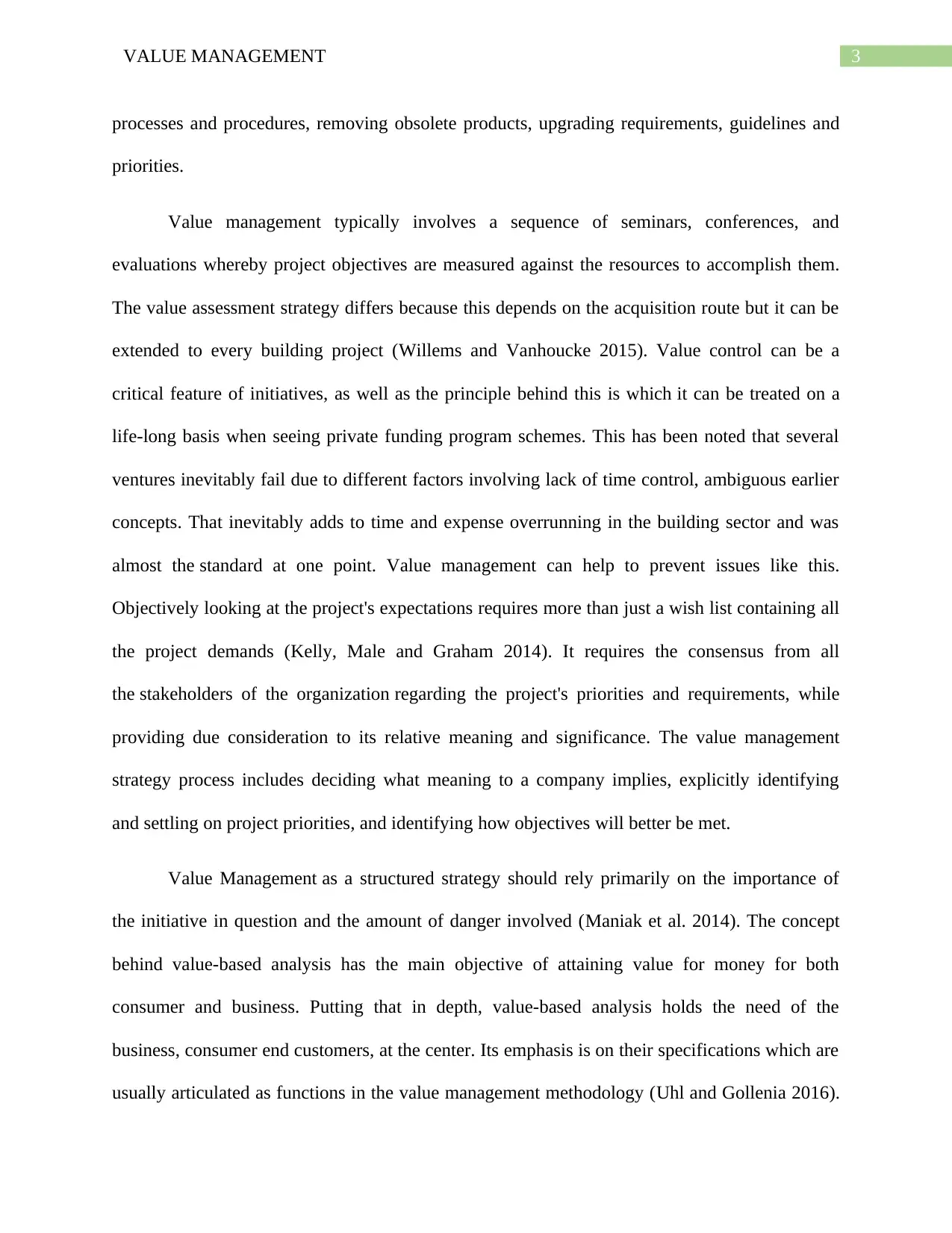
3VALUE MANAGEMENT
processes and procedures, removing obsolete products, upgrading requirements, guidelines and
priorities.
Value management typically involves a sequence of seminars, conferences, and
evaluations whereby project objectives are measured against the resources to accomplish them.
The value assessment strategy differs because this depends on the acquisition route but it can be
extended to every building project (Willems and Vanhoucke 2015). Value control can be a
critical feature of initiatives, as well as the principle behind this is which it can be treated on a
life-long basis when seeing private funding program schemes. This has been noted that several
ventures inevitably fail due to different factors involving lack of time control, ambiguous earlier
concepts. That inevitably adds to time and expense overrunning in the building sector and was
almost the standard at one point. Value management can help to prevent issues like this.
Objectively looking at the project's expectations requires more than just a wish list containing all
the project demands (Kelly, Male and Graham 2014). It requires the consensus from all
the stakeholders of the organization regarding the project's priorities and requirements, while
providing due consideration to its relative meaning and significance. The value management
strategy process includes deciding what meaning to a company implies, explicitly identifying
and settling on project priorities, and identifying how objectives will better be met.
Value Management as a structured strategy should rely primarily on the importance of
the initiative in question and the amount of danger involved (Maniak et al. 2014). The concept
behind value-based analysis has the main objective of attaining value for money for both
consumer and business. Putting that in depth, value-based analysis holds the need of the
business, consumer end customers, at the center. Its emphasis is on their specifications which are
usually articulated as functions in the value management methodology (Uhl and Gollenia 2016).
processes and procedures, removing obsolete products, upgrading requirements, guidelines and
priorities.
Value management typically involves a sequence of seminars, conferences, and
evaluations whereby project objectives are measured against the resources to accomplish them.
The value assessment strategy differs because this depends on the acquisition route but it can be
extended to every building project (Willems and Vanhoucke 2015). Value control can be a
critical feature of initiatives, as well as the principle behind this is which it can be treated on a
life-long basis when seeing private funding program schemes. This has been noted that several
ventures inevitably fail due to different factors involving lack of time control, ambiguous earlier
concepts. That inevitably adds to time and expense overrunning in the building sector and was
almost the standard at one point. Value management can help to prevent issues like this.
Objectively looking at the project's expectations requires more than just a wish list containing all
the project demands (Kelly, Male and Graham 2014). It requires the consensus from all
the stakeholders of the organization regarding the project's priorities and requirements, while
providing due consideration to its relative meaning and significance. The value management
strategy process includes deciding what meaning to a company implies, explicitly identifying
and settling on project priorities, and identifying how objectives will better be met.
Value Management as a structured strategy should rely primarily on the importance of
the initiative in question and the amount of danger involved (Maniak et al. 2014). The concept
behind value-based analysis has the main objective of attaining value for money for both
consumer and business. Putting that in depth, value-based analysis holds the need of the
business, consumer end customers, at the center. Its emphasis is on their specifications which are
usually articulated as functions in the value management methodology (Uhl and Gollenia 2016).
Secure Best Marks with AI Grader
Need help grading? Try our AI Grader for instant feedback on your assignments.
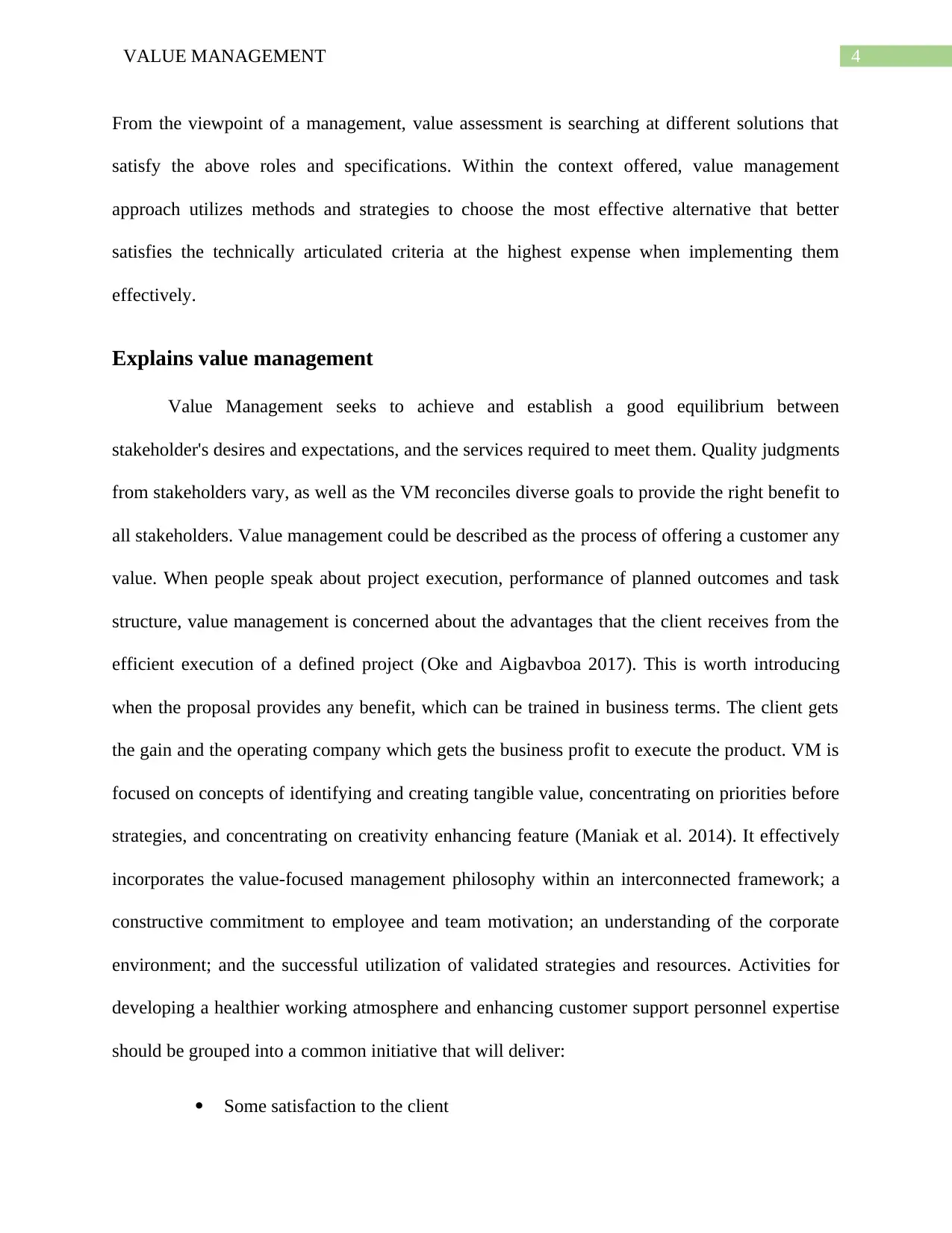
4VALUE MANAGEMENT
From the viewpoint of a management, value assessment is searching at different solutions that
satisfy the above roles and specifications. Within the context offered, value management
approach utilizes methods and strategies to choose the most effective alternative that better
satisfies the technically articulated criteria at the highest expense when implementing them
effectively.
Explains value management
Value Management seeks to achieve and establish a good equilibrium between
stakeholder's desires and expectations, and the services required to meet them. Quality judgments
from stakeholders vary, as well as the VM reconciles diverse goals to provide the right benefit to
all stakeholders. Value management could be described as the process of offering a customer any
value. When people speak about project execution, performance of planned outcomes and task
structure, value management is concerned about the advantages that the client receives from the
efficient execution of a defined project (Oke and Aigbavboa 2017). This is worth introducing
when the proposal provides any benefit, which can be trained in business terms. The client gets
the gain and the operating company which gets the business profit to execute the product. VM is
focused on concepts of identifying and creating tangible value, concentrating on priorities before
strategies, and concentrating on creativity enhancing feature (Maniak et al. 2014). It effectively
incorporates the value-focused management philosophy within an interconnected framework; a
constructive commitment to employee and team motivation; an understanding of the corporate
environment; and the successful utilization of validated strategies and resources. Activities for
developing a healthier working atmosphere and enhancing customer support personnel expertise
should be grouped into a common initiative that will deliver:
Some satisfaction to the client
From the viewpoint of a management, value assessment is searching at different solutions that
satisfy the above roles and specifications. Within the context offered, value management
approach utilizes methods and strategies to choose the most effective alternative that better
satisfies the technically articulated criteria at the highest expense when implementing them
effectively.
Explains value management
Value Management seeks to achieve and establish a good equilibrium between
stakeholder's desires and expectations, and the services required to meet them. Quality judgments
from stakeholders vary, as well as the VM reconciles diverse goals to provide the right benefit to
all stakeholders. Value management could be described as the process of offering a customer any
value. When people speak about project execution, performance of planned outcomes and task
structure, value management is concerned about the advantages that the client receives from the
efficient execution of a defined project (Oke and Aigbavboa 2017). This is worth introducing
when the proposal provides any benefit, which can be trained in business terms. The client gets
the gain and the operating company which gets the business profit to execute the product. VM is
focused on concepts of identifying and creating tangible value, concentrating on priorities before
strategies, and concentrating on creativity enhancing feature (Maniak et al. 2014). It effectively
incorporates the value-focused management philosophy within an interconnected framework; a
constructive commitment to employee and team motivation; an understanding of the corporate
environment; and the successful utilization of validated strategies and resources. Activities for
developing a healthier working atmosphere and enhancing customer support personnel expertise
should be grouped into a common initiative that will deliver:
Some satisfaction to the client
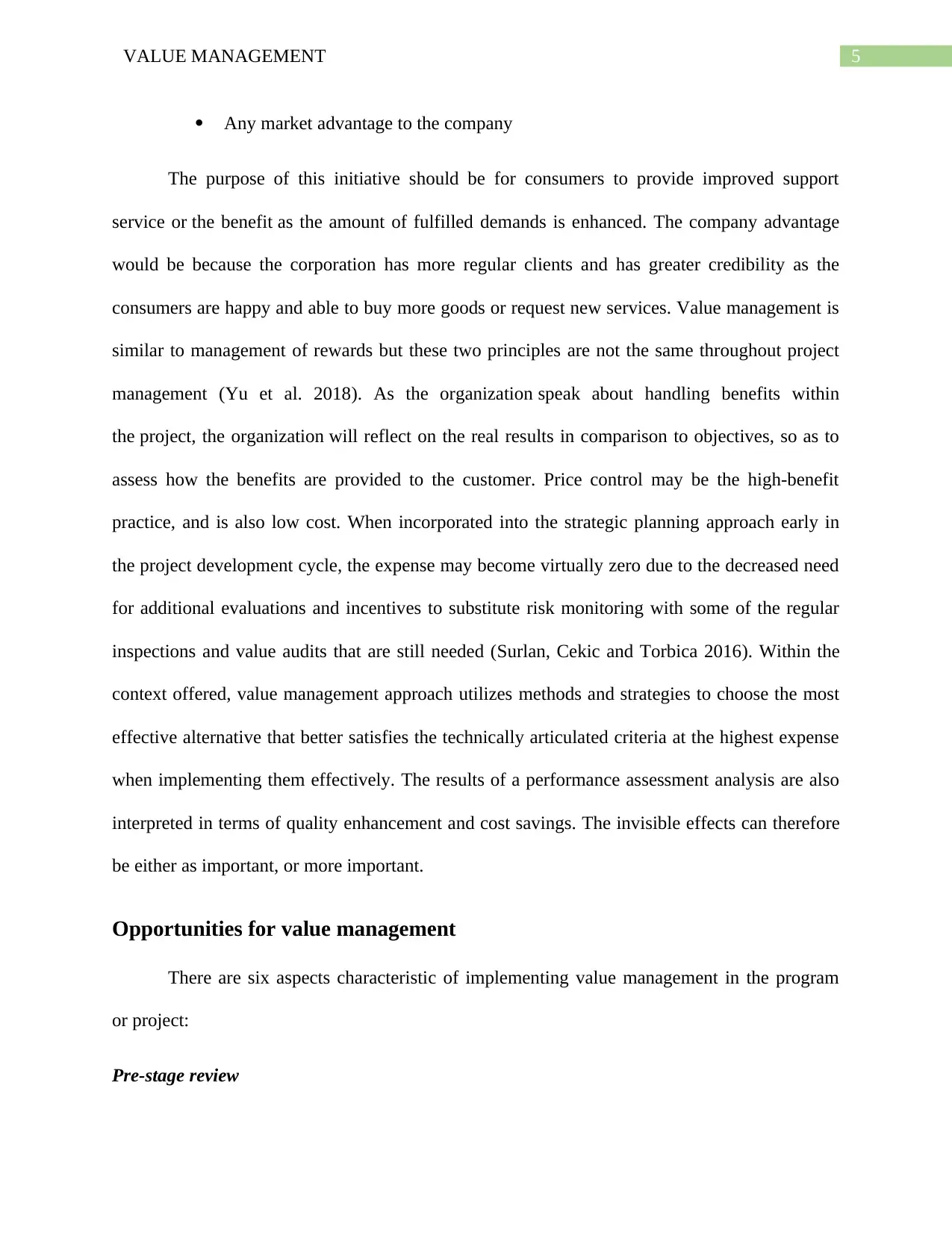
5VALUE MANAGEMENT
Any market advantage to the company
The purpose of this initiative should be for consumers to provide improved support
service or the benefit as the amount of fulfilled demands is enhanced. The company advantage
would be because the corporation has more regular clients and has greater credibility as the
consumers are happy and able to buy more goods or request new services. Value management is
similar to management of rewards but these two principles are not the same throughout project
management (Yu et al. 2018). As the organization speak about handling benefits within
the project, the organization will reflect on the real results in comparison to objectives, so as to
assess how the benefits are provided to the customer. Price control may be the high-benefit
practice, and is also low cost. When incorporated into the strategic planning approach early in
the project development cycle, the expense may become virtually zero due to the decreased need
for additional evaluations and incentives to substitute risk monitoring with some of the regular
inspections and value audits that are still needed (Surlan, Cekic and Torbica 2016). Within the
context offered, value management approach utilizes methods and strategies to choose the most
effective alternative that better satisfies the technically articulated criteria at the highest expense
when implementing them effectively. The results of a performance assessment analysis are also
interpreted in terms of quality enhancement and cost savings. The invisible effects can therefore
be either as important, or more important.
Opportunities for value management
There are six aspects characteristic of implementing value management in the program
or project:
Pre-stage review
Any market advantage to the company
The purpose of this initiative should be for consumers to provide improved support
service or the benefit as the amount of fulfilled demands is enhanced. The company advantage
would be because the corporation has more regular clients and has greater credibility as the
consumers are happy and able to buy more goods or request new services. Value management is
similar to management of rewards but these two principles are not the same throughout project
management (Yu et al. 2018). As the organization speak about handling benefits within
the project, the organization will reflect on the real results in comparison to objectives, so as to
assess how the benefits are provided to the customer. Price control may be the high-benefit
practice, and is also low cost. When incorporated into the strategic planning approach early in
the project development cycle, the expense may become virtually zero due to the decreased need
for additional evaluations and incentives to substitute risk monitoring with some of the regular
inspections and value audits that are still needed (Surlan, Cekic and Torbica 2016). Within the
context offered, value management approach utilizes methods and strategies to choose the most
effective alternative that better satisfies the technically articulated criteria at the highest expense
when implementing them effectively. The results of a performance assessment analysis are also
interpreted in terms of quality enhancement and cost savings. The invisible effects can therefore
be either as important, or more important.
Opportunities for value management
There are six aspects characteristic of implementing value management in the program
or project:
Pre-stage review
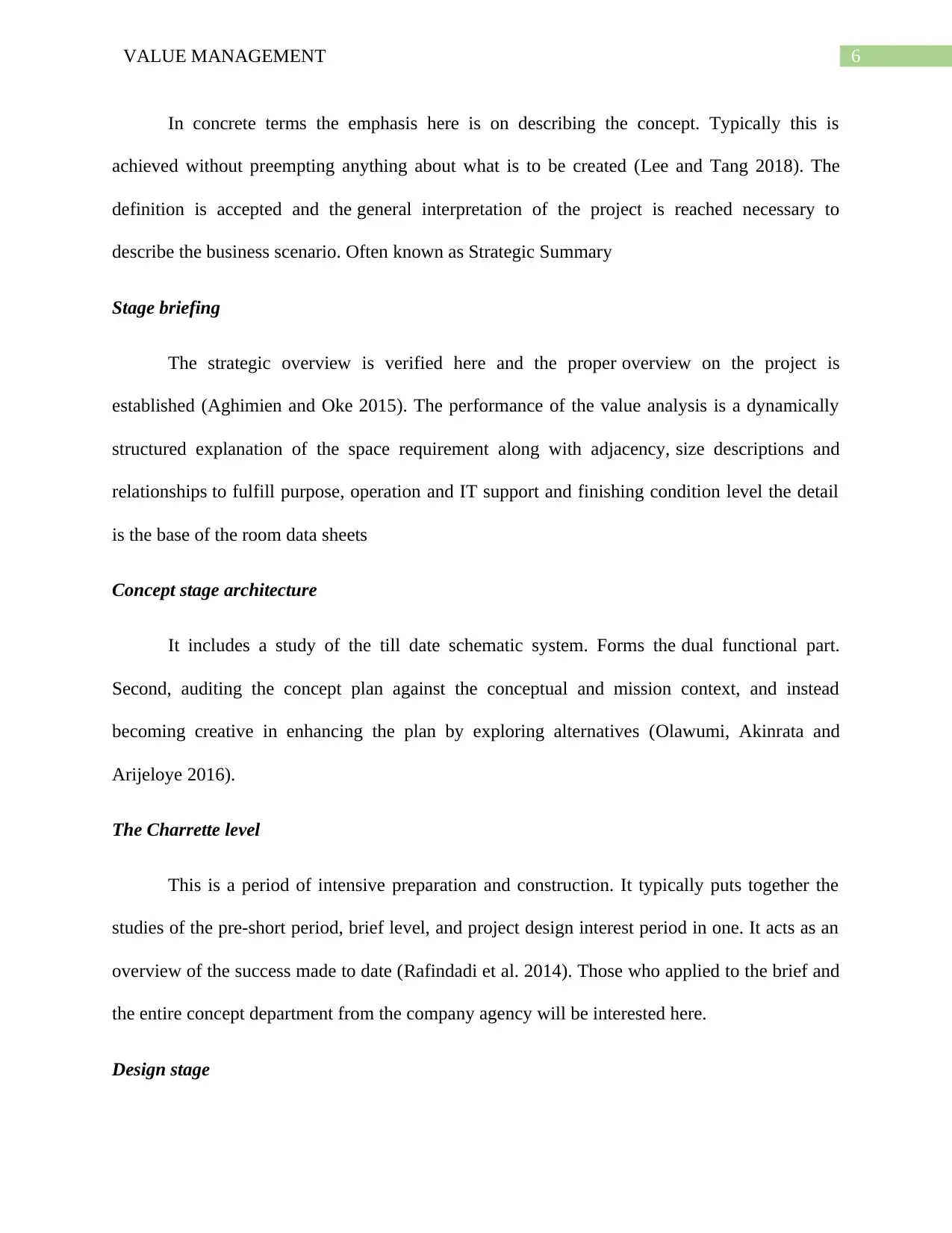
6VALUE MANAGEMENT
In concrete terms the emphasis here is on describing the concept. Typically this is
achieved without preempting anything about what is to be created (Lee and Tang 2018). The
definition is accepted and the general interpretation of the project is reached necessary to
describe the business scenario. Often known as Strategic Summary
Stage briefing
The strategic overview is verified here and the proper overview on the project is
established (Aghimien and Oke 2015). The performance of the value analysis is a dynamically
structured explanation of the space requirement along with adjacency, size descriptions and
relationships to fulfill purpose, operation and IT support and finishing condition level the detail
is the base of the room data sheets
Concept stage architecture
It includes a study of the till date schematic system. Forms the dual functional part.
Second, auditing the concept plan against the conceptual and mission context, and instead
becoming creative in enhancing the plan by exploring alternatives (Olawumi, Akinrata and
Arijeloye 2016).
The Charrette level
This is a period of intensive preparation and construction. It typically puts together the
studies of the pre-short period, brief level, and project design interest period in one. It acts as an
overview of the success made to date (Rafindadi et al. 2014). Those who applied to the brief and
the entire concept department from the company agency will be interested here.
Design stage
In concrete terms the emphasis here is on describing the concept. Typically this is
achieved without preempting anything about what is to be created (Lee and Tang 2018). The
definition is accepted and the general interpretation of the project is reached necessary to
describe the business scenario. Often known as Strategic Summary
Stage briefing
The strategic overview is verified here and the proper overview on the project is
established (Aghimien and Oke 2015). The performance of the value analysis is a dynamically
structured explanation of the space requirement along with adjacency, size descriptions and
relationships to fulfill purpose, operation and IT support and finishing condition level the detail
is the base of the room data sheets
Concept stage architecture
It includes a study of the till date schematic system. Forms the dual functional part.
Second, auditing the concept plan against the conceptual and mission context, and instead
becoming creative in enhancing the plan by exploring alternatives (Olawumi, Akinrata and
Arijeloye 2016).
The Charrette level
This is a period of intensive preparation and construction. It typically puts together the
studies of the pre-short period, brief level, and project design interest period in one. It acts as an
overview of the success made to date (Rafindadi et al. 2014). Those who applied to the brief and
the entire concept department from the company agency will be interested here.
Design stage
Paraphrase This Document
Need a fresh take? Get an instant paraphrase of this document with our AI Paraphraser
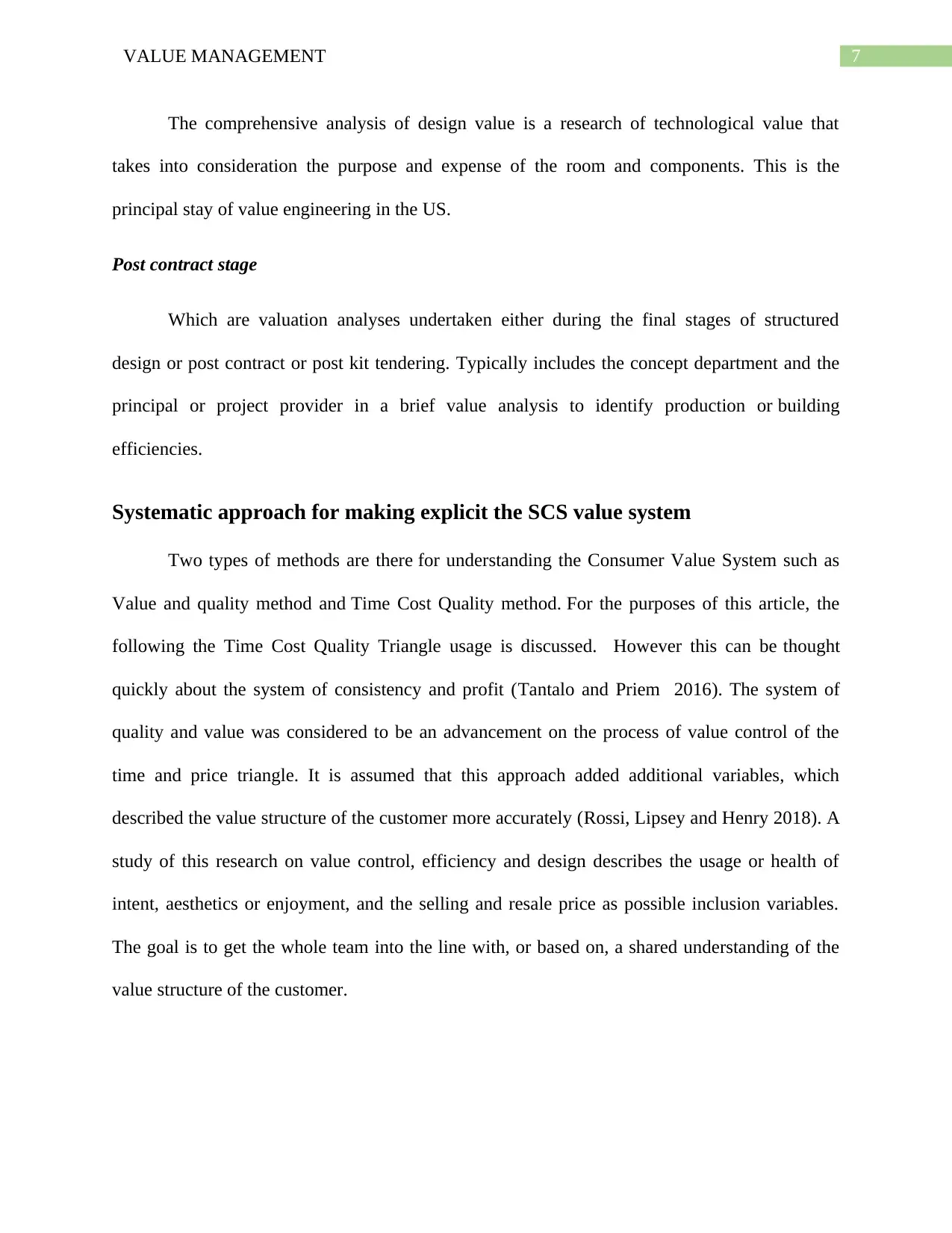
7VALUE MANAGEMENT
The comprehensive analysis of design value is a research of technological value that
takes into consideration the purpose and expense of the room and components. This is the
principal stay of value engineering in the US.
Post contract stage
Which are valuation analyses undertaken either during the final stages of structured
design or post contract or post kit tendering. Typically includes the concept department and the
principal or project provider in a brief value analysis to identify production or building
efficiencies.
Systematic approach for making explicit the SCS value system
Two types of methods are there for understanding the Consumer Value System such as
Value and quality method and Time Cost Quality method. For the purposes of this article, the
following the Time Cost Quality Triangle usage is discussed. However this can be thought
quickly about the system of consistency and profit (Tantalo and Priem 2016). The system of
quality and value was considered to be an advancement on the process of value control of the
time and price triangle. It is assumed that this approach added additional variables, which
described the value structure of the customer more accurately (Rossi, Lipsey and Henry 2018). A
study of this research on value control, efficiency and design describes the usage or health of
intent, aesthetics or enjoyment, and the selling and resale price as possible inclusion variables.
The goal is to get the whole team into the line with, or based on, a shared understanding of the
value structure of the customer.
The comprehensive analysis of design value is a research of technological value that
takes into consideration the purpose and expense of the room and components. This is the
principal stay of value engineering in the US.
Post contract stage
Which are valuation analyses undertaken either during the final stages of structured
design or post contract or post kit tendering. Typically includes the concept department and the
principal or project provider in a brief value analysis to identify production or building
efficiencies.
Systematic approach for making explicit the SCS value system
Two types of methods are there for understanding the Consumer Value System such as
Value and quality method and Time Cost Quality method. For the purposes of this article, the
following the Time Cost Quality Triangle usage is discussed. However this can be thought
quickly about the system of consistency and profit (Tantalo and Priem 2016). The system of
quality and value was considered to be an advancement on the process of value control of the
time and price triangle. It is assumed that this approach added additional variables, which
described the value structure of the customer more accurately (Rossi, Lipsey and Henry 2018). A
study of this research on value control, efficiency and design describes the usage or health of
intent, aesthetics or enjoyment, and the selling and resale price as possible inclusion variables.
The goal is to get the whole team into the line with, or based on, a shared understanding of the
value structure of the customer.
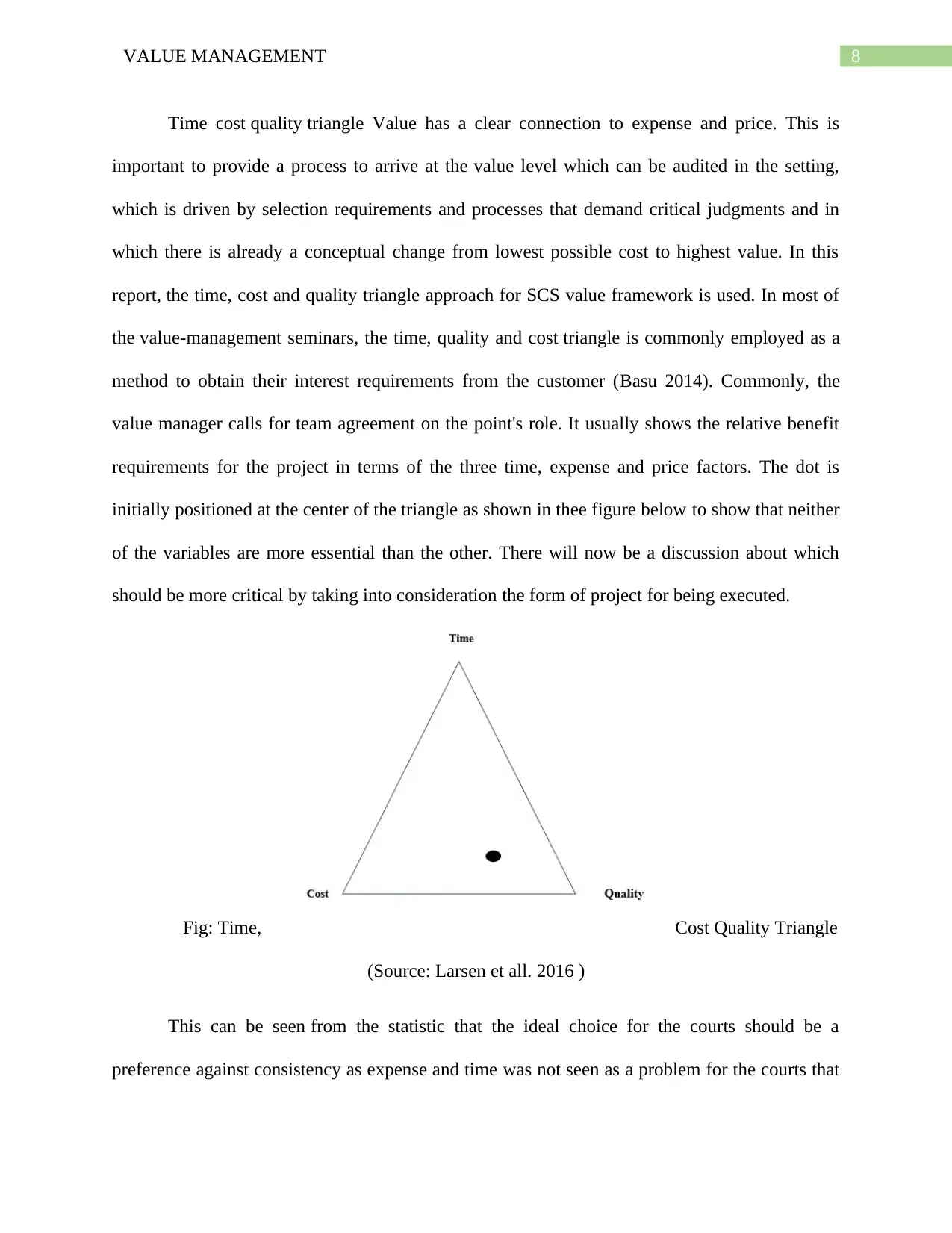
8VALUE MANAGEMENT
Time cost quality triangle Value has a clear connection to expense and price. This is
important to provide a process to arrive at the value level which can be audited in the setting,
which is driven by selection requirements and processes that demand critical judgments and in
which there is already a conceptual change from lowest possible cost to highest value. In this
report, the time, cost and quality triangle approach for SCS value framework is used. In most of
the value-management seminars, the time, quality and cost triangle is commonly employed as a
method to obtain their interest requirements from the customer (Basu 2014). Commonly, the
value manager calls for team agreement on the point's role. It usually shows the relative benefit
requirements for the project in terms of the three time, expense and price factors. The dot is
initially positioned at the center of the triangle as shown in thee figure below to show that neither
of the variables are more essential than the other. There will now be a discussion about which
should be more critical by taking into consideration the form of project for being executed.
Fig: Time, Cost Quality Triangle
(Source: Larsen et all. 2016 )
This can be seen from the statistic that the ideal choice for the courts should be a
preference against consistency as expense and time was not seen as a problem for the courts that
Time cost quality triangle Value has a clear connection to expense and price. This is
important to provide a process to arrive at the value level which can be audited in the setting,
which is driven by selection requirements and processes that demand critical judgments and in
which there is already a conceptual change from lowest possible cost to highest value. In this
report, the time, cost and quality triangle approach for SCS value framework is used. In most of
the value-management seminars, the time, quality and cost triangle is commonly employed as a
method to obtain their interest requirements from the customer (Basu 2014). Commonly, the
value manager calls for team agreement on the point's role. It usually shows the relative benefit
requirements for the project in terms of the three time, expense and price factors. The dot is
initially positioned at the center of the triangle as shown in thee figure below to show that neither
of the variables are more essential than the other. There will now be a discussion about which
should be more critical by taking into consideration the form of project for being executed.
Fig: Time, Cost Quality Triangle
(Source: Larsen et all. 2016 )
This can be seen from the statistic that the ideal choice for the courts should be a
preference against consistency as expense and time was not seen as a problem for the courts that
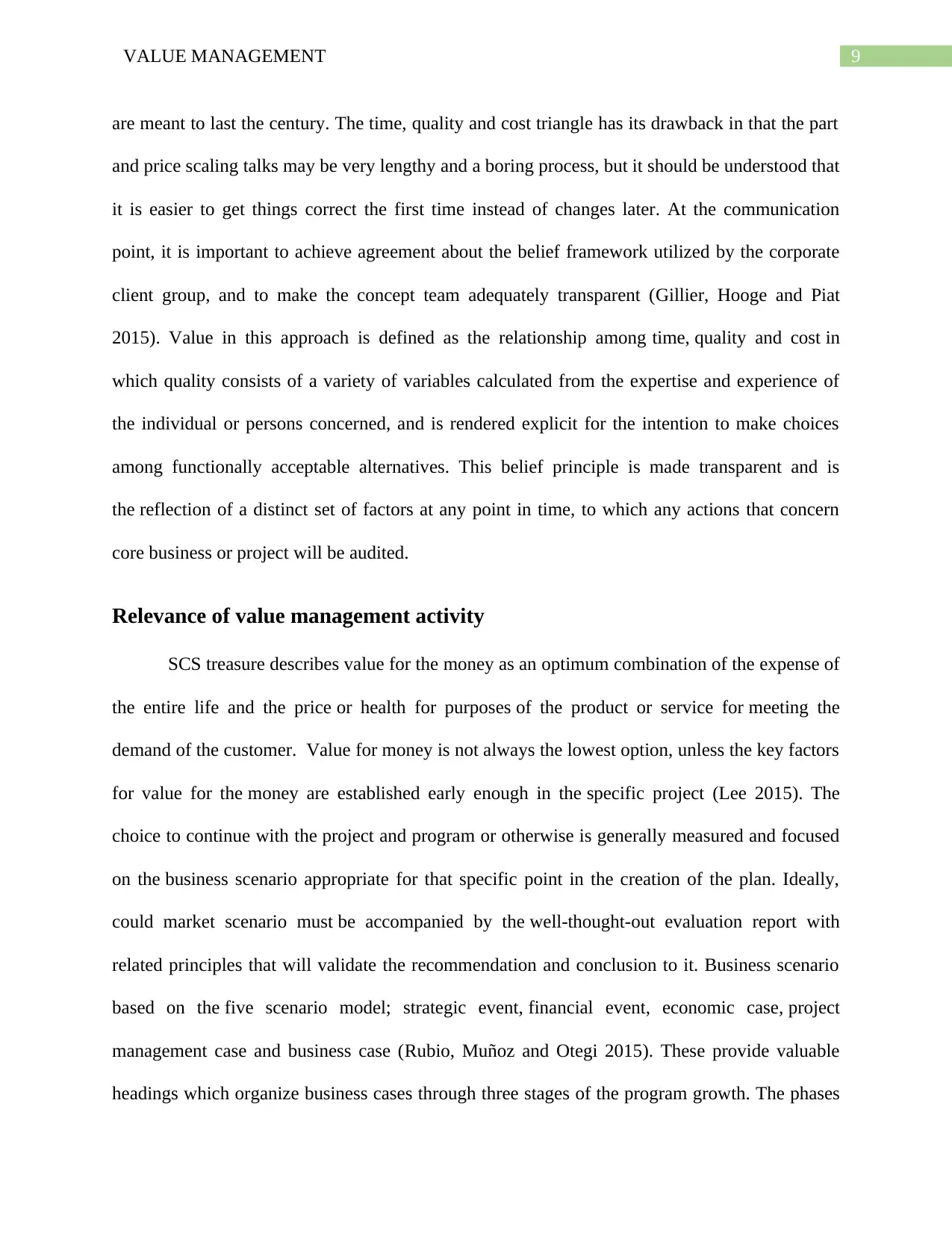
9VALUE MANAGEMENT
are meant to last the century. The time, quality and cost triangle has its drawback in that the part
and price scaling talks may be very lengthy and a boring process, but it should be understood that
it is easier to get things correct the first time instead of changes later. At the communication
point, it is important to achieve agreement about the belief framework utilized by the corporate
client group, and to make the concept team adequately transparent (Gillier, Hooge and Piat
2015). Value in this approach is defined as the relationship among time, quality and cost in
which quality consists of a variety of variables calculated from the expertise and experience of
the individual or persons concerned, and is rendered explicit for the intention to make choices
among functionally acceptable alternatives. This belief principle is made transparent and is
the reflection of a distinct set of factors at any point in time, to which any actions that concern
core business or project will be audited.
Relevance of value management activity
SCS treasure describes value for the money as an optimum combination of the expense of
the entire life and the price or health for purposes of the product or service for meeting the
demand of the customer. Value for money is not always the lowest option, unless the key factors
for value for the money are established early enough in the specific project (Lee 2015). The
choice to continue with the project and program or otherwise is generally measured and focused
on the business scenario appropriate for that specific point in the creation of the plan. Ideally,
could market scenario must be accompanied by the well-thought-out evaluation report with
related principles that will validate the recommendation and conclusion to it. Business scenario
based on the five scenario model; strategic event, financial event, economic case, project
management case and business case (Rubio, Muñoz and Otegi 2015). These provide valuable
headings which organize business cases through three stages of the program growth. The phases
are meant to last the century. The time, quality and cost triangle has its drawback in that the part
and price scaling talks may be very lengthy and a boring process, but it should be understood that
it is easier to get things correct the first time instead of changes later. At the communication
point, it is important to achieve agreement about the belief framework utilized by the corporate
client group, and to make the concept team adequately transparent (Gillier, Hooge and Piat
2015). Value in this approach is defined as the relationship among time, quality and cost in
which quality consists of a variety of variables calculated from the expertise and experience of
the individual or persons concerned, and is rendered explicit for the intention to make choices
among functionally acceptable alternatives. This belief principle is made transparent and is
the reflection of a distinct set of factors at any point in time, to which any actions that concern
core business or project will be audited.
Relevance of value management activity
SCS treasure describes value for the money as an optimum combination of the expense of
the entire life and the price or health for purposes of the product or service for meeting the
demand of the customer. Value for money is not always the lowest option, unless the key factors
for value for the money are established early enough in the specific project (Lee 2015). The
choice to continue with the project and program or otherwise is generally measured and focused
on the business scenario appropriate for that specific point in the creation of the plan. Ideally,
could market scenario must be accompanied by the well-thought-out evaluation report with
related principles that will validate the recommendation and conclusion to it. Business scenario
based on the five scenario model; strategic event, financial event, economic case, project
management case and business case (Rubio, Muñoz and Otegi 2015). These provide valuable
headings which organize business cases through three stages of the program growth. The phases
Secure Best Marks with AI Grader
Need help grading? Try our AI Grader for instant feedback on your assignments.
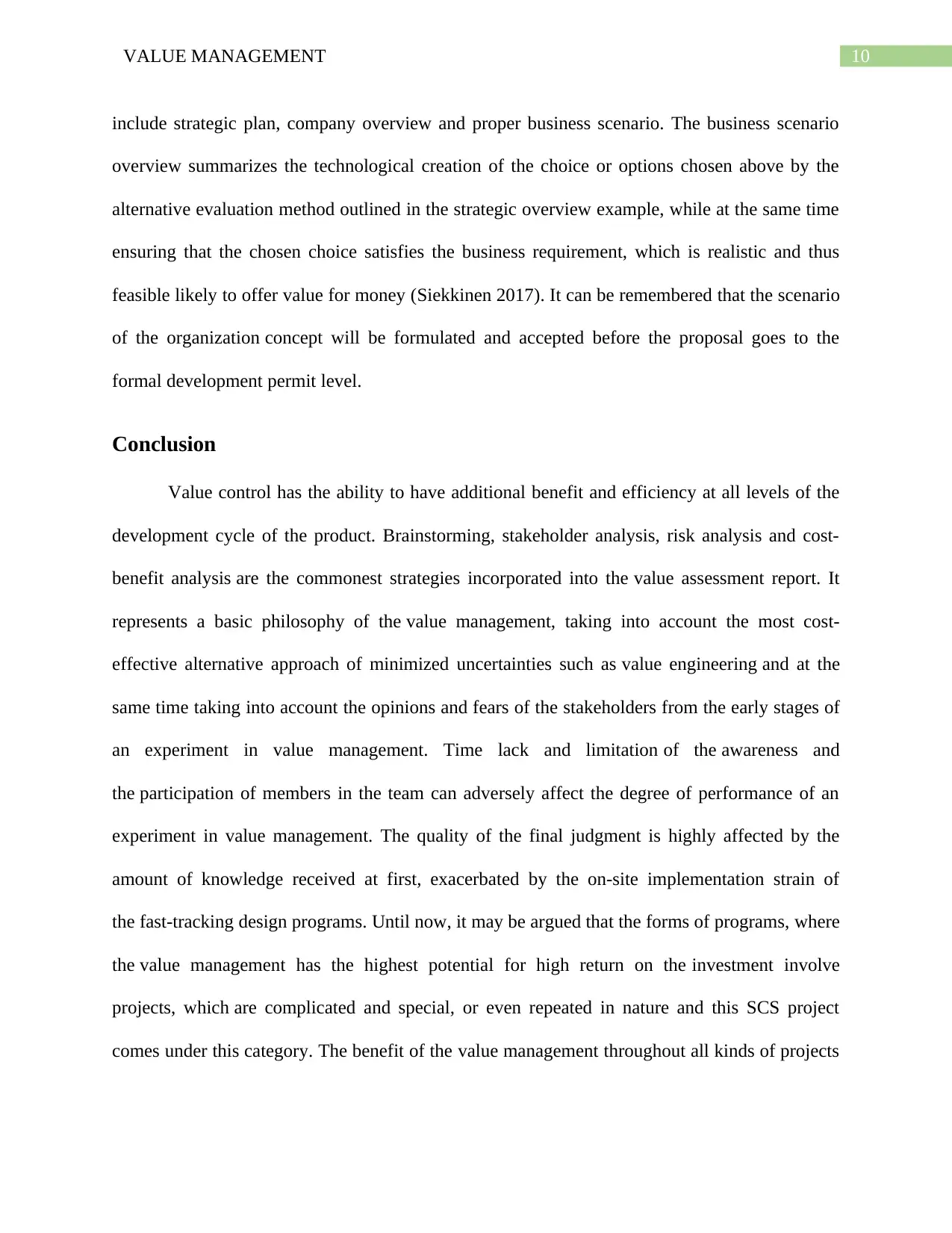
10VALUE MANAGEMENT
include strategic plan, company overview and proper business scenario. The business scenario
overview summarizes the technological creation of the choice or options chosen above by the
alternative evaluation method outlined in the strategic overview example, while at the same time
ensuring that the chosen choice satisfies the business requirement, which is realistic and thus
feasible likely to offer value for money (Siekkinen 2017). It can be remembered that the scenario
of the organization concept will be formulated and accepted before the proposal goes to the
formal development permit level.
Conclusion
Value control has the ability to have additional benefit and efficiency at all levels of the
development cycle of the product. Brainstorming, stakeholder analysis, risk analysis and cost-
benefit analysis are the commonest strategies incorporated into the value assessment report. It
represents a basic philosophy of the value management, taking into account the most cost-
effective alternative approach of minimized uncertainties such as value engineering and at the
same time taking into account the opinions and fears of the stakeholders from the early stages of
an experiment in value management. Time lack and limitation of the awareness and
the participation of members in the team can adversely affect the degree of performance of an
experiment in value management. The quality of the final judgment is highly affected by the
amount of knowledge received at first, exacerbated by the on-site implementation strain of
the fast-tracking design programs. Until now, it may be argued that the forms of programs, where
the value management has the highest potential for high return on the investment involve
projects, which are complicated and special, or even repeated in nature and this SCS project
comes under this category. The benefit of the value management throughout all kinds of projects
include strategic plan, company overview and proper business scenario. The business scenario
overview summarizes the technological creation of the choice or options chosen above by the
alternative evaluation method outlined in the strategic overview example, while at the same time
ensuring that the chosen choice satisfies the business requirement, which is realistic and thus
feasible likely to offer value for money (Siekkinen 2017). It can be remembered that the scenario
of the organization concept will be formulated and accepted before the proposal goes to the
formal development permit level.
Conclusion
Value control has the ability to have additional benefit and efficiency at all levels of the
development cycle of the product. Brainstorming, stakeholder analysis, risk analysis and cost-
benefit analysis are the commonest strategies incorporated into the value assessment report. It
represents a basic philosophy of the value management, taking into account the most cost-
effective alternative approach of minimized uncertainties such as value engineering and at the
same time taking into account the opinions and fears of the stakeholders from the early stages of
an experiment in value management. Time lack and limitation of the awareness and
the participation of members in the team can adversely affect the degree of performance of an
experiment in value management. The quality of the final judgment is highly affected by the
amount of knowledge received at first, exacerbated by the on-site implementation strain of
the fast-tracking design programs. Until now, it may be argued that the forms of programs, where
the value management has the highest potential for high return on the investment involve
projects, which are complicated and special, or even repeated in nature and this SCS project
comes under this category. The benefit of the value management throughout all kinds of projects

11VALUE MANAGEMENT
and programs largely depend on each individual member's commitment and initiative to form the
team of value management and design.
and programs largely depend on each individual member's commitment and initiative to form the
team of value management and design.
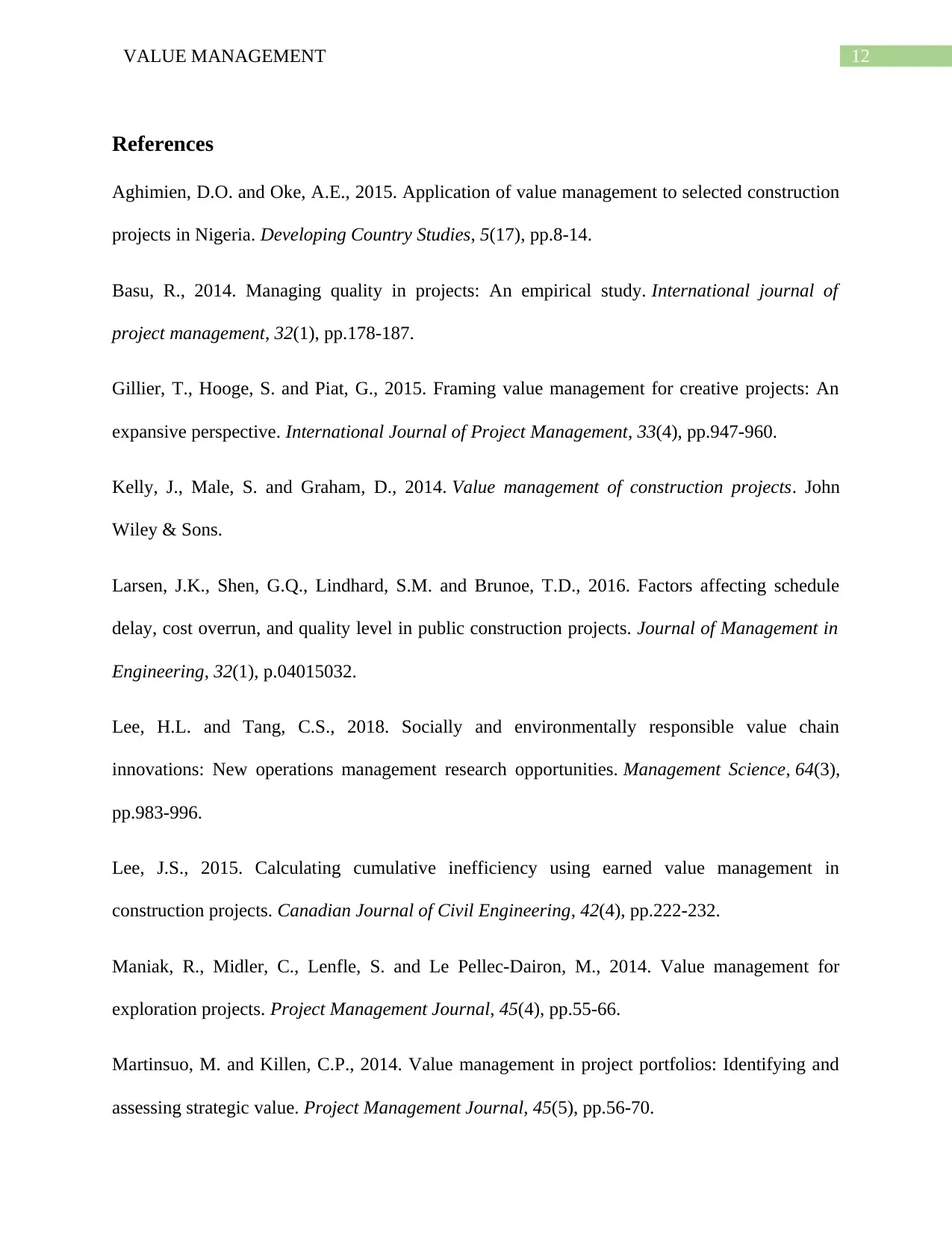
12VALUE MANAGEMENT
References
Aghimien, D.O. and Oke, A.E., 2015. Application of value management to selected construction
projects in Nigeria. Developing Country Studies, 5(17), pp.8-14.
Basu, R., 2014. Managing quality in projects: An empirical study. International journal of
project management, 32(1), pp.178-187.
Gillier, T., Hooge, S. and Piat, G., 2015. Framing value management for creative projects: An
expansive perspective. International Journal of Project Management, 33(4), pp.947-960.
Kelly, J., Male, S. and Graham, D., 2014. Value management of construction projects. John
Wiley & Sons.
Larsen, J.K., Shen, G.Q., Lindhard, S.M. and Brunoe, T.D., 2016. Factors affecting schedule
delay, cost overrun, and quality level in public construction projects. Journal of Management in
Engineering, 32(1), p.04015032.
Lee, H.L. and Tang, C.S., 2018. Socially and environmentally responsible value chain
innovations: New operations management research opportunities. Management Science, 64(3),
pp.983-996.
Lee, J.S., 2015. Calculating cumulative inefficiency using earned value management in
construction projects. Canadian Journal of Civil Engineering, 42(4), pp.222-232.
Maniak, R., Midler, C., Lenfle, S. and Le Pellec-Dairon, M., 2014. Value management for
exploration projects. Project Management Journal, 45(4), pp.55-66.
Martinsuo, M. and Killen, C.P., 2014. Value management in project portfolios: Identifying and
assessing strategic value. Project Management Journal, 45(5), pp.56-70.
References
Aghimien, D.O. and Oke, A.E., 2015. Application of value management to selected construction
projects in Nigeria. Developing Country Studies, 5(17), pp.8-14.
Basu, R., 2014. Managing quality in projects: An empirical study. International journal of
project management, 32(1), pp.178-187.
Gillier, T., Hooge, S. and Piat, G., 2015. Framing value management for creative projects: An
expansive perspective. International Journal of Project Management, 33(4), pp.947-960.
Kelly, J., Male, S. and Graham, D., 2014. Value management of construction projects. John
Wiley & Sons.
Larsen, J.K., Shen, G.Q., Lindhard, S.M. and Brunoe, T.D., 2016. Factors affecting schedule
delay, cost overrun, and quality level in public construction projects. Journal of Management in
Engineering, 32(1), p.04015032.
Lee, H.L. and Tang, C.S., 2018. Socially and environmentally responsible value chain
innovations: New operations management research opportunities. Management Science, 64(3),
pp.983-996.
Lee, J.S., 2015. Calculating cumulative inefficiency using earned value management in
construction projects. Canadian Journal of Civil Engineering, 42(4), pp.222-232.
Maniak, R., Midler, C., Lenfle, S. and Le Pellec-Dairon, M., 2014. Value management for
exploration projects. Project Management Journal, 45(4), pp.55-66.
Martinsuo, M. and Killen, C.P., 2014. Value management in project portfolios: Identifying and
assessing strategic value. Project Management Journal, 45(5), pp.56-70.
Paraphrase This Document
Need a fresh take? Get an instant paraphrase of this document with our AI Paraphraser
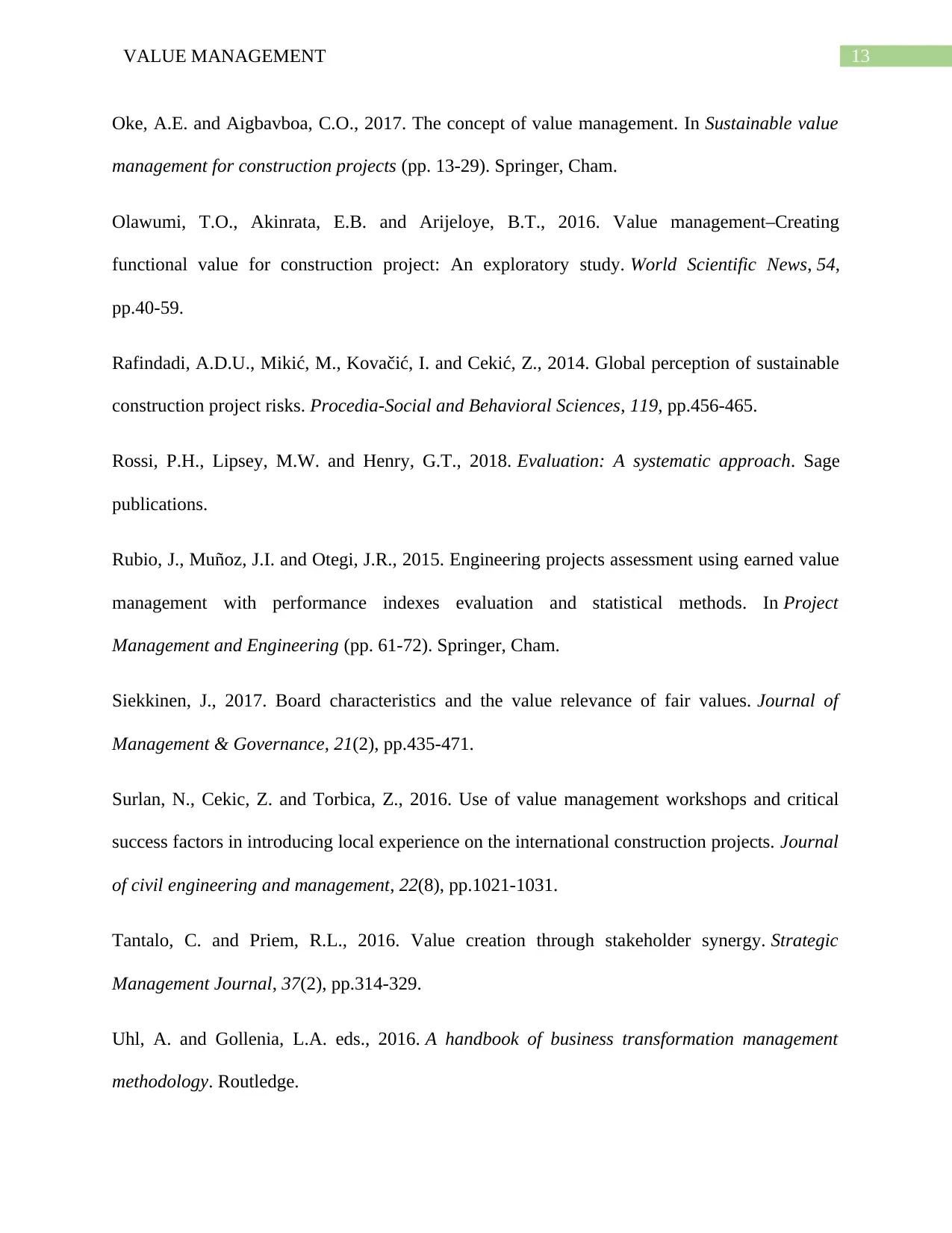
13VALUE MANAGEMENT
Oke, A.E. and Aigbavboa, C.O., 2017. The concept of value management. In Sustainable value
management for construction projects (pp. 13-29). Springer, Cham.
Olawumi, T.O., Akinrata, E.B. and Arijeloye, B.T., 2016. Value management–Creating
functional value for construction project: An exploratory study. World Scientific News, 54,
pp.40-59.
Rafindadi, A.D.U., Mikić, M., Kovačić, I. and Cekić, Z., 2014. Global perception of sustainable
construction project risks. Procedia-Social and Behavioral Sciences, 119, pp.456-465.
Rossi, P.H., Lipsey, M.W. and Henry, G.T., 2018. Evaluation: A systematic approach. Sage
publications.
Rubio, J., Muñoz, J.I. and Otegi, J.R., 2015. Engineering projects assessment using earned value
management with performance indexes evaluation and statistical methods. In Project
Management and Engineering (pp. 61-72). Springer, Cham.
Siekkinen, J., 2017. Board characteristics and the value relevance of fair values. Journal of
Management & Governance, 21(2), pp.435-471.
Surlan, N., Cekic, Z. and Torbica, Z., 2016. Use of value management workshops and critical
success factors in introducing local experience on the international construction projects. Journal
of civil engineering and management, 22(8), pp.1021-1031.
Tantalo, C. and Priem, R.L., 2016. Value creation through stakeholder synergy. Strategic
Management Journal, 37(2), pp.314-329.
Uhl, A. and Gollenia, L.A. eds., 2016. A handbook of business transformation management
methodology. Routledge.
Oke, A.E. and Aigbavboa, C.O., 2017. The concept of value management. In Sustainable value
management for construction projects (pp. 13-29). Springer, Cham.
Olawumi, T.O., Akinrata, E.B. and Arijeloye, B.T., 2016. Value management–Creating
functional value for construction project: An exploratory study. World Scientific News, 54,
pp.40-59.
Rafindadi, A.D.U., Mikić, M., Kovačić, I. and Cekić, Z., 2014. Global perception of sustainable
construction project risks. Procedia-Social and Behavioral Sciences, 119, pp.456-465.
Rossi, P.H., Lipsey, M.W. and Henry, G.T., 2018. Evaluation: A systematic approach. Sage
publications.
Rubio, J., Muñoz, J.I. and Otegi, J.R., 2015. Engineering projects assessment using earned value
management with performance indexes evaluation and statistical methods. In Project
Management and Engineering (pp. 61-72). Springer, Cham.
Siekkinen, J., 2017. Board characteristics and the value relevance of fair values. Journal of
Management & Governance, 21(2), pp.435-471.
Surlan, N., Cekic, Z. and Torbica, Z., 2016. Use of value management workshops and critical
success factors in introducing local experience on the international construction projects. Journal
of civil engineering and management, 22(8), pp.1021-1031.
Tantalo, C. and Priem, R.L., 2016. Value creation through stakeholder synergy. Strategic
Management Journal, 37(2), pp.314-329.
Uhl, A. and Gollenia, L.A. eds., 2016. A handbook of business transformation management
methodology. Routledge.
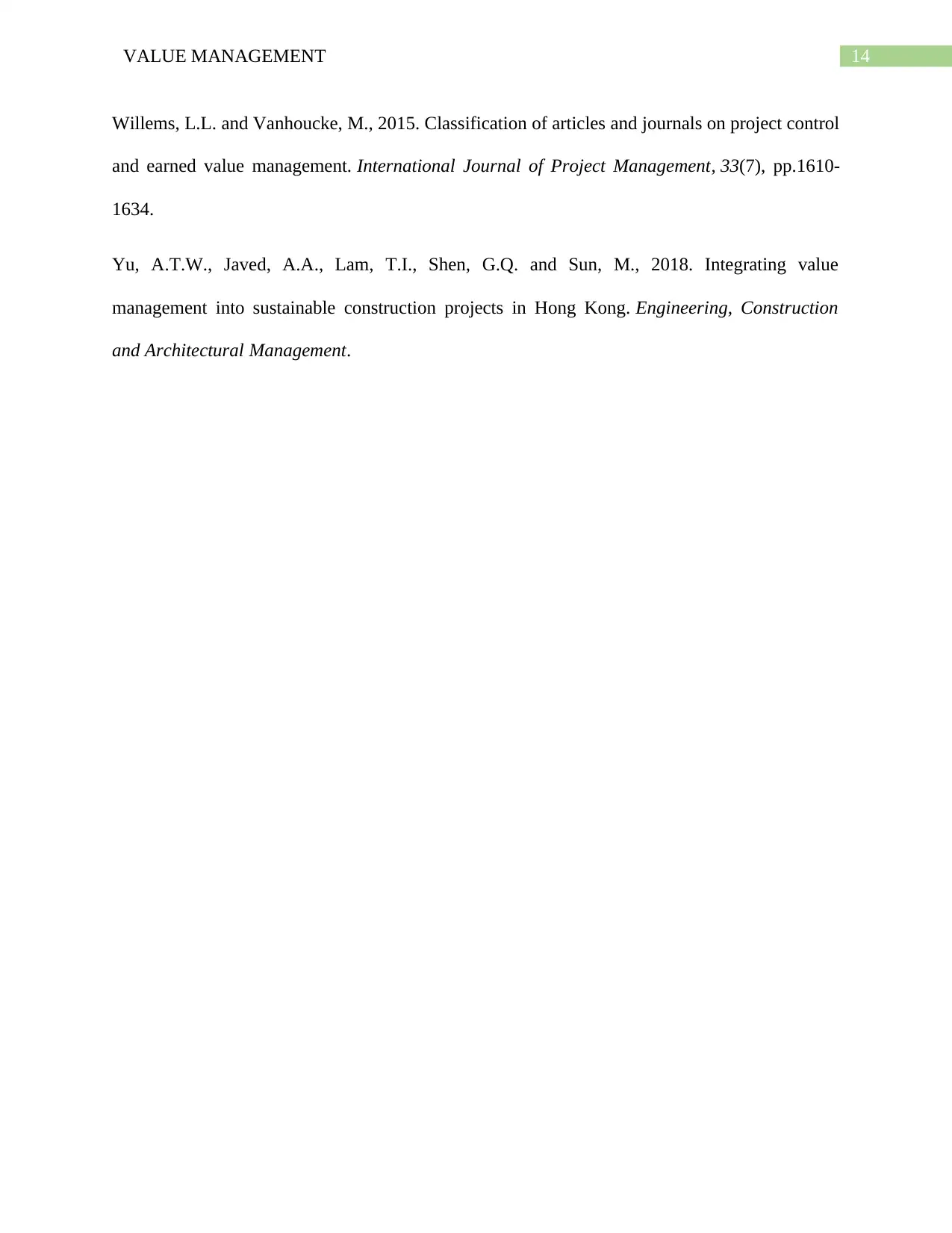
14VALUE MANAGEMENT
Willems, L.L. and Vanhoucke, M., 2015. Classification of articles and journals on project control
and earned value management. International Journal of Project Management, 33(7), pp.1610-
1634.
Yu, A.T.W., Javed, A.A., Lam, T.I., Shen, G.Q. and Sun, M., 2018. Integrating value
management into sustainable construction projects in Hong Kong. Engineering, Construction
and Architectural Management.
Willems, L.L. and Vanhoucke, M., 2015. Classification of articles and journals on project control
and earned value management. International Journal of Project Management, 33(7), pp.1610-
1634.
Yu, A.T.W., Javed, A.A., Lam, T.I., Shen, G.Q. and Sun, M., 2018. Integrating value
management into sustainable construction projects in Hong Kong. Engineering, Construction
and Architectural Management.
1 out of 15
Related Documents
Your All-in-One AI-Powered Toolkit for Academic Success.
+13062052269
info@desklib.com
Available 24*7 on WhatsApp / Email
![[object Object]](/_next/static/media/star-bottom.7253800d.svg)
Unlock your academic potential
© 2024 | Zucol Services PVT LTD | All rights reserved.





